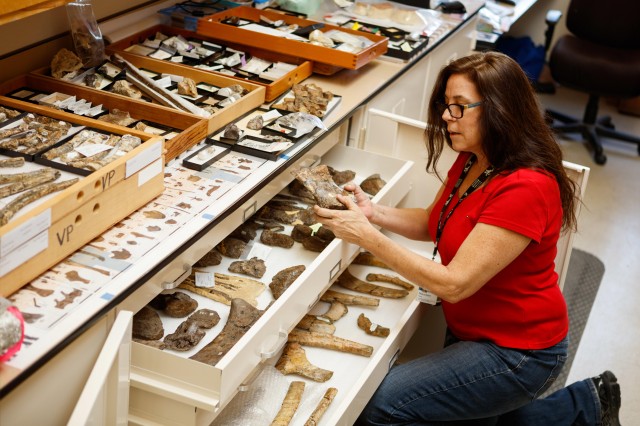Meet Our Polar Explorer
Dr. Nathan Smith, Associate Curator of NHM’s Dinosaur Institute, is an experienced Antarctic fossil hunter.

Dr. Nathan Smith, Associate Curator of NHM’s Dinosaur Institute, is an experienced Antarctic fossil hunter. On expeditions in 2003 and 2010–11, Smith and a team of international scientists visited the Beardmore Glacier to excavate dinosaur bones from a quarry on Mount Kirkpatrick. He recently returned from a three-month expedition to Antarctica in 2017–18, collecting fossils from before the Age of Dinosaurs. The Naturalist asked Smith how he prepped for his Antarctic journeys, what passes for recreation on the icy continent, and for more details on the creatures that occupied that remote patch of Earth millions of years ago.
Hi Nate. First off— what’s it like just to be there?
Antarctica is like going to another world. You feel as if you’ve gone to a remote mining or moon colony or something. When you get down to McMurdo Station, the big operation there, that’s where we’re doing all our prep and getting things ready. But, our research is actually taking place further into the mountains and that’s another long plane ride, setting up, basically from scratch, a camp out in the middle of nowhere on the ice.
How did you prep for it?
Leading up to this, we have a ton of work to do. That means marshaling resources and setting our priorities for the research and exploration. Our own team has to decide what tools and resources we need. Once we’re in Antarctica, those doing remote research have to complete “snow school” — an overnight around McMurdo Station, where folks from the U.S. Antarctic Program train you. The survival bag has everything you need if you get stuck in a bad storm and nobody can pick you up for a while: stove, fuel, food, tents, sleeping bags, radio — even a trashy romance novel to read as you wait in your tent to be rescued.
How chilly was it at the remote camp?
At the site where the dinosaurs are, you’re at altitude, about 12,500 feet. So, it can get pretty cold, down to minus 20, minus 25 Fahrenheit in some cases.
How was the cuisine?
The team of U.S. Antarctic Program chefs are really amazing. They have to feed over 1,000 people at McMurdo Station during Summer. They make sure that you’re getting everything you need for nutrition, and that it’s varied and tasty. Any field paleontologist can tell you that the quickest way to get morale up in a field camp is to feed people well.
What did you do for fun?
There’s a lot of stuff available. Over the years, we set up volleyball nets out on the ice or played kickball. Folks that were down there built a nice little cross-country ski trail. We also played a softball game on a field we created. Lots of people also will play cards or board games. Knitting is surprisingly popular in Antarctica; tons of people do it because it helps pass the time, it’s a calming activity, and you’re producing something you can use down there.
What creature comforts did you miss most?
Surprisingly, not things like access to the internet or TV; it’s really good fresh vegetables and fresh fruit. So, whenever you get the opportunity to get some, everybody kind of rejoices.
How do you feel about being on a continuum of generations of Antarctic explorers?
We have it really good now, in terms of how safe it is to do work down there. I found it’s helpful when you’re there on a really cold day or, if the weather’s bad, to step out of your own context for a second and think about what would it have been like to be me, on this mountainside 50 or 100 years ago, and then you just kinda think, yep, I should stop complaining now.
What are biggest misconceptions people have about the place?
One of the most startling things to people is that even though most of Antarctica is covered in ice, there are a lot of ice-free areas, where you’ve got the mountains rising up out of the ice. We’re not actually carving and digging holes in the ice. We’re going to where rocks are exposed and hunting for little bits of fossil weathering out. The other big surprise to people is the concept that in the past, millions of years ago, Antarctica was free of ice and different landscapes hosted all kinds of plants and animals, including dinosaurs.
When you find fossils, how do you unearth them?
Where our dinosaurs are from — Mount Kirkpatrick, near the Beardmore Glacier — that is a very, very hard kind of silicified sedimentary rock, almost like concrete. So, we use rock saws as well as 60-pound jack hammers and drills to cut channels around the fossil and then use hand tools to chisel out large, 800-pound blocks to take back. We wrap the blocks in a big cargo net with a chain and a hook on it. Our pilot hovers over it as our mountaineer hooks the cargo net up and then the helicopter lifts off.
One of the big surprises for people is the concept that, in the past — millions of years ago — Antarctica was free of ice, and different landscapes hosted all kinds of plants and animals, including 11 dinosaurs.
—Dr. Nathan Smith, Associate Curator of NHM’s Dinosaur Institute
